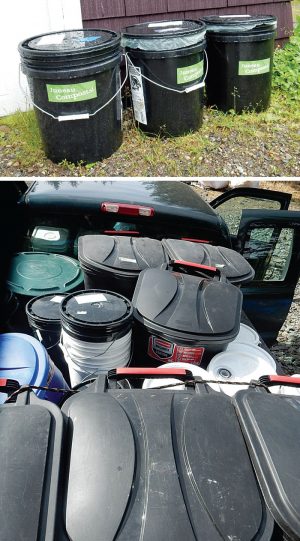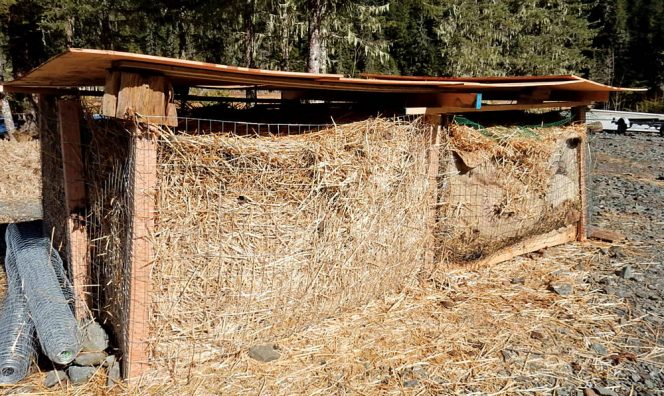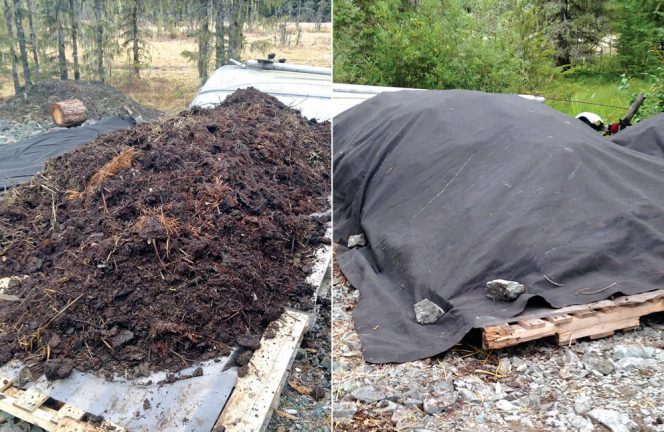Juneau Composts grew from a Master Gardener certification project into a food scraps collection and composting enterprise.
Marsha W. Johnston
BioCycle November/December 2018

Customers purchase 5-gallon buckets or provide their own. Juneau Composts uses a pickup truck for food scraps collection; buckets are emptied into 45-gallon trash containers in the truck bed. Photos courtesy of Juneau Composts
Juneau Composts didn’t need a land use or environmental permit from the State of Alaska either, because Daugherty proposed to process under the maximum of 5 tons of compost/organic waste per day. Juneau Composts opened for business in April 2017, after Daugherty was granted the business license.
Master Gardener Project
In establishing Juneau Composts, Daugherty realized her dream to turn her Master Gardener certification project into a business. To become a master gardener, she had to complete a 40-hour volunteer project, so she started a free food scraps collection service in 2012. “There really is no soil suitable for gardening here,” says Daugherty. “Everything is in raised beds, and you have to either buy or make your own soil. I was trying to install a huge garden, and I wanted to prove to people in Juneau that hot composting could be done here, because no one was doing it. Many people thought it wasn’t possible because of our climate and bear population, or thought you needed to wait three years to get a finished product.”
She signed up 20 people, picked up their buckets and composted the organics in her yard for a year. “I accepted everything except meat and fish, including non-meat cooked food, salad dressing, and bioplastics,” recalls Daugherty. “It worked, and didn’t cause any bear problems.” Daugherty wrote her Master Gardener paper and a mini-business plan, but decided to wait a few years until her son was older before attempting to start a business.
Residential And Commercial Collection
Juneau Composts takes all pre and postconsumer food waste except meat and seafood (due to bear issues at the curb), as well as BPI-certified bioplastic packaging, serviceware, and compostable paper and packaging. Food scraps are collected from approximately 135 residential accounts and a dozen small businesses. An average of 1,700 pounds/week are collected.
Customers use 5-gallon buckets that can be purchased from Juneau Composts, or they can supply their own. The company has a pickup truck that carries 45-gallon trash containers; 5-gallon buckets are emptied into the containers. Residential pickup is once a week, while businesses are once or twice a week.
Daugherty’s collection service has a unique sliding rate of between $7 and $25/month. “The idea came out of a moment of heartbreak, when the first person who wanted to sign up backed off when I sent the $25 invoice,” she explains. With a self-described mission to grow the compost movement and realizing that some people might not be able to afford $25 a month, Daugherty evaluated how to reach the most people. She came up with having people serve as a collection hub, with one house getting neighbors to put their buckets together.

Eight-foot by eight-foot pallet bins are used for the first phase of composting. Photos courtesy of Juneau Composts
Composting Operation
The composting site is on less than half of a 2-acre gravel pad. “I own this land and it happened to have the right zoning,” explains Daugherty. “If I didn’t, this never would have all come together.” Permitting will not have to be considered for a while, as Juneau Composts’ volume would have to grow 20-fold to exceed the 5 tons/day (including carbon) maximum restriction.
Finding carbon feedstocks can be a challenge with no farms in the vicinity. “In the fall, I try to stockpile leaves, and in spring I stockpile moss,” she says. “Customers and community members bag them up from their yards for me to take.” The leaves and moss are unloaded into an open-sided shed to dry out. Daugherty also collects sawdust and shavings from a couple of woodworkers, and, as a last resort, she will buy straw that is barged in from Washington. “Last winter, I was buying quite a bit of straw,” she notes.
Eight-foot by eight-foot pallet bins are used for initial processing. Daugherty builds the pile so that it passively aerates and reaches 140°F degrees. “This initial breakdown lasts about 6 weeks, and I aerate it using a 6-foot piece of rebar when the pile temperature starts to drop,” she explains. “The rebar is slightly curved at one end that makes pushing it into the pile easy. I just make a grid of holes into the piles from all sides. Super high-tech! But it works to reheat the pile!”
The pile then gets turned and put into another bin, where it reheats and sits for another one to two months. It also gets aerated using rebar when the temperature starts to drop. Material goes through this heating and turning three times before the last bin is unloaded and put into a windrow.

After 2 to 3 months of composting in the bins, material is moved for curing into a windrow that is covered with breathable fabric. Photos courtesy of Juneau Composts
To determine if finished compost is ready for use, Daugherty sifts a test batch and does a Solvita respiration and pH test, and conducts a grow trial with it. “If everything looks good from those three aspects, I consider it done,” she says.
Daugherty just bagged the first batch of compost. From 10,000 pounds of food waste, she got 2,000 pounds of 3/8-inch compost. She also ended up with approximately two cubic yards of material that was over 3/8-inch, which is being reserved for her next batch. “My compost goes back to customers who want it, which is about one-third to one-half of them,” she says. The remainder is sold online.
“My business model is to grow slowly within the company’s financial means so that complete failure is unlikely,” Daugherty explains. Already, her collection fees cover all monthly costs, with money left over to save for future equipment and infrastructure needs.
As part of her mission to grow the compost movement, Daugherty also holds home and neighborhood composting workshops, helps set up new systems, and troubleshoots when assistance is needed. Last winter, she started the Alaska Compost Network. A Facebook group at this point, she hopes to grow the Network into a forum that will connect composters in Alaska, from big producers to backyard aficionados, to share best practices, “instead of staying in our own little worlds.”
Marsha W. Johnston, an editor with Earth Steward Associates, is a Contributing Editor to BioCycle.










